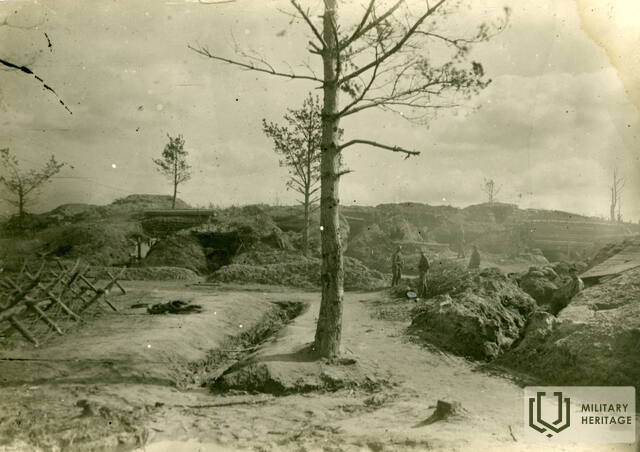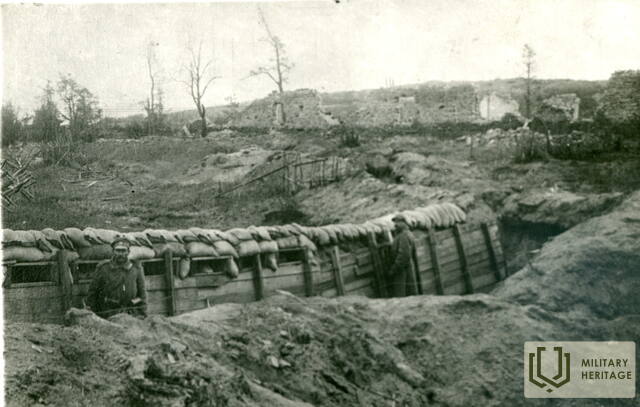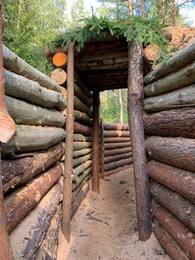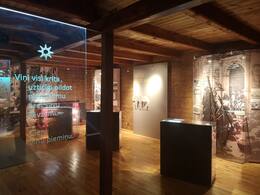Latvijos lankininkų kasdienybė Mirties saloje

Prisiminimuose vaizdingai aprašoma Mirties salos karių kasdienybė.
"Gyvenimas Mirties saloje buvo kupinas vargų ir baisybių. Naktį, temstant ir iki aušros, į mūšio stotį buvo atgabentos karinės medžiagos ir maistas, sužeistieji ir žuvusieji išvežti į dešinįjį krantą. Sugriuvę apkasai ir eismo praėjimai, sugadintas telefonų srautas buvo skubiai taisomi. Priešas nemiegojo. Virš minų užtaisų sprogo tik kvartalas. ryte buvo pabudę, nors šauliai gyveno uolose ir palaidoti žemėje, bet urvuose ir iškasuose matėsi net sodo gėlės ir drovios kaimo gražuolės. Narsūs latvių berniukai atnešė juos iš „neutralios žemės“, kuri buvo tarp šaulių ir vokiečio dieną, o naktinis buvo skirtas visokioms išdaigoms. Bet toks ir yra latvis – jis moka rasti ar sukurti grožį net ir blogiausiomis gyvenimo akimirkomis. Gėlės nenuvyto lankininkų apkasuose ir neprarijo dainų skambesio net sunkiausiomis nevilties akimirkomis. Šauliams karas buvo šventa užduotis ir net vokiečių uraganas negalėjo nutildyti jų širdžių džiaugsmo. Rytais ir vakarais, kai paprastai mūšio triukšmas aprimdavo, lankininkai šias poilsio akimirkas leisdavo dainuodami liaudies dainas. Vokiečiai atsakė dainuodami savo karo dainas. Neretai apkasuose mandolinomis ar gitaromis grodavo abu priešininkai. Atrodė, kad jie jau nebe priešai, bet tarp dviejų priešų užsimezgė draugystė. Kartais rytais ir vakarais tarp mūsų ir priešo vykdavo taikiausi santykiai, tačiau sutemus prasidėdavo abipusės kovos dėl gyvybės ir mirties. Net tyliam, didingam, ramiam latvių likimui, juodajai Dauguvos upei, nebuvo leista svyruoti. Neretai joje iškildavo aukšti vandens stulpai, užburti vokiškų granatų, kurių purslai krito atgal į Dauguvą, sutrikdydami jos ramybę. Žemyn plūduriavo šimtai negyvų ir apsvaigusių žuvų. Lankininkai bandė juo pasinaudoti ir Dauguvoje žemiau šaudymo taško bandė gaudyti „kontūzytas“ žuvis, o po geros medžioklės suvalgė vokiečių jiems parūpintą žuvies sriubą. Medžioklė buvo ypač sėkminga, kai Dauguvos žemupyje buvo pastatytas plaukiojantis tiltas. Apskritai, kad ir kaip šaudymo metu vokiečių artilerijos ugnis buvo pavojinga ir mirtina fiziškai bei morališkai, ji tylintiems šauliams suteikė malonių akimirkų. Kol ugnis per dieną nurimo, visi nuėjo į skardžius ieškoti vokiškų kriauklių aliuminio ir kaparėlių galvučių. Dažnai lankininkai būriais skubėdavo į kritusio užtaiso vietą. Už ką? Tačiau tie, kurie patyrė lankininkų laiką, prisimins, kad tokius keistus baltus žiedus pirštuose turėjo beveik visi lankininkai, porai dienų išvykę į Rygą atostogų ar pas gimines. Jie buvo lankininkų išradimas ir kūrinys. Aliuminis buvo pašalintas iš sviedinių galvučių ir ištirpintas. Anksčiau jis jau iškirpdavo reikiamą formą gipsu ir tada liedavo! Šauliai gamino įvairių formų žiedus: apskritimą su širdele, labai išraiškingą žvaigždę, kai kurie žiedai turėjo sulydytą granatos ašmenį ir pan. Šauliai mėgo šiuos apskritimus, nes jie ryškiai priminė viską, ką patyrė ir patyrė Mirties saloje. Iš tos pačios medžiagos lankininkai liejo ne tik žiedus, bet ir gamino šaukštus, mažas statulėles bei kitus įdomius daiktus. Iš rankinių granatų fakelų kaparinių vamzdelių pradėtos gaminti kandikliai, išskyrus sprogstantį gyvsidabrį. Žinoma, pasitaikydavo ir nelaimingų atsitikimų ir vienas lankininkas neteko ne tik pirštų, rankų, bet ir gyvybės. Visas nesprogusias vokiškas granatas ar skeveldras šauliai pamažu išardydavo, iškraudavo ir paversdavo vazomis, geriamaisiais indais, o daugumą jų kaip mielą prisiminimą iš mūšio lauko siųsdavo artimiesiems. Šis karas lankininkams buvo šventas karas ir viskas, kas susiję su mūšiais, tapo šventa, verta atminimo. Kaip stipri ir pasitikinti buvo šaulių dvasia, nes jie negalėjo netikėti savo pergale, taip pat uoliai rūpinosi savo karo ginklų priežiūra ir saugojimu, o tai taip pat turi didelę reikšmę kario gyvenime. Pagrindinis šaulių ginklas buvo šautuvas. Tai buvo jų draugas baltomis ir nebaltomis dienomis. Ne veltui lankininkai laiškuose ją vadino „žmona“ ir „sužadėtine“. Mirties saloje visą dieną galėjai pamatyti, kaip lankininkai valo šautuvus, deglus, drabužius, batus ir kt. Iššluoti šautuvai buvo patalpinti į specialiai paruoštas stačias saugyklas čia pat, apkasuose, kad bet kurią akimirką būtų po ranka ir būtų galima nedelsiant pradėti dirbti.
http://latviesustrelniekusaraksts.lv/Kaujas_darbiba/Book_2.html (žiūrėta 2021-07-20
Susijusi laiko juosta
Susijusios temos
Susijusios vietos
Mirties sala
Salų grupė yra Dauguvoje, Rygos HE rezervuaro pietinėje pusėje, netoli Daugmalės. Mirties sala yra vienas baisiausių ir legendomis apipintų Pirmojo pasaulinio karo mūšio laukų. Kai 1915 m. Rusijos armija pasitraukė iš Kuržemės ir Žiemgalos, kai kurie daliniai liko kairiajame Dauguvos krante, kur užėmė pozicijas kovai su Vokietijos armija. Upės krantus jungė tiltas. Čia įvyko vienas didžiausių cheminio ginklo panaudojimo atvejų Latvijos teritorijoje. Latvijos kareiviai šią vietą vadino „Mirties sala“, o kitų tautybių kareiviai – „Pragaru“. Mirties salos vieta turėjo strateginę ir simbolinę reikšmę. Latvijos kareiviams ji buvo Vokietijos okupuotos Kuržemės dalis. Kovos vyko Dauguvos pakrantėse netoli Ikškilės, kurios tam tikra prasme buvo susijusios su protėvių kovomis kryžiaus žygių metu. Šiandien į šią vietą galima patekti laivu. Galima pamatyti neužtvindytą Rygos HE rezervuaro teritoriją. Vis dar išlikęs E. Laubės suprojektuotas paminklas. Kai kuriose vietose rekonstruoti gynybinės pozicijos elementai. Dauguvos krante, netoli Ikškilės Kābelių kalvos, yra informacinis stendas. Mirties sala tapo salų grupe, kai buvo baigta statyti Rygos HE rezervuaras.
Kultūros paveldo centras „Tīnūžų dvaras“
Kultūros paveldo centras „Tīnūžių dvaras“ yra Ogrės savivaldybėje, Tīnūžių kaime, 7 km nuo Ogrės ir Ikškilės miestų. Pirmieji rašytiniai duomenys apie dvarą siekia XVI a. Iki XVIII a. vidurio jis buvo laikomas ekonominiu gamybos vienetu su mažais ir nereikšmingais pastatais. Tačiau laikui bėgant jis išaugo į didelį ūkį. Pirmojo pasaulinio karo metu čia vyko Rusijos ir Vokietijos armijų mūšiai, kuriuose dalyvavo ir Latvijos šauliai. Nepriklausomybės karo metu Tīnūžių dvaras buvo naudojamas kaip Latvijos armijos 1-ojo Valmieros pėstininkų pulko štabas ir šarvuočių aikštelė. 1932 m. dvaras buvo perduotas Latvijos karo invalidų sąjungai, kuri apgyvendino ir rūpinosi karo veteranais. Antrojo pasaulinio karo metu (1943 m.) iš Estijos į Tīnūžių dvarą buvo perkeltas Vokietijos armijos dalinys FAT 212. Tai buvo diversantų dalinys, rengęs karius kovai su Raudonąja armija. Latvijos kareiviai taip pat buvo apmokyti žvalgybos rinkimo, partizaninio karo taktikos ir sabotažo menų. Tīnūžių dvaro pono rūmai buvo sugriauti, kai Raudonoji armija judėjo Rygos link. Šiandien tai vieta su nuostabiu kraštovaizdžiu ir istoriniais pastatais Mažosios Juglos upės pakrantėje. Kultūros paveldo centre „Tīnūžių dvaras“ galima pamatyti ekspozicijas, skirtas istoriniams įvykiams, įskaitant ir tas, kurios susijusios su Latvijos šauliais.









